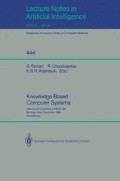Abstract
Exception handling has received much attention in several areas recently. In this paper, we accomodate exceptions in a semantic network model using an object-oriented approach. First, the semantic model is adequately described to allow the introduction of exceptions. Then the categories of exceptions in the model are examined. An Object-Property diagram is introduced to model the exceptions. This paper attempts to provide an alternative and better approach in handling exceptions for semantic network models. Specifically, we describe previous work done on exception handling on semantic models and introduce our proposed approach. We show how our model addresses the limitations of the previous approach as well as providing more leverage to the system.
Preview
Unable to display preview. Download preview PDF.
References
Borgida, A., Generalization/Specialization as a Basis for Software Specification, On Conceptual Modelling, ed. Mylopoulos, J., Brodie, M. and Schmidt, J., Springer-Verlag, Virginia, pp. 87–114, 1984.
Borgida, A. and Williamson, K., Accomodating Exceptions in Database and Refining the Schema by learning from them, Proceedings of 11th Int'l Conference on Very Large Data Bases, Stockholm, pp. 72–81, 1985.
Borgida, A, Mitchell, T and Williamson, K, Learning Integrity Constraint in Databases and Knowledge Bases, On Knowledge Base Management Systems, ed. Brodie, M. and Mylopoulos, J, Springer-Verlag, Virginia, pp.259–286, 1986.
Borgida, A., Modelling Class Hierarchies with Contradictions, Proceedings of SIGMOD Conference, Chicago, pp. 434–443, 1988.
Carey, M., DeWitt, D. and Vandenberg, S., A Data Model and Query Language for EXODUS, Proceedings of SIGMOD Conference, Chicago, pp. 413–423, 1988.
Chen,P.P., The Entity-Relationship model:Toward a unified view of data, ACM Transactions on Database System, March, pp. 9–37, 1976.
Digitalk Inc Corporation, Smalltalk/V Tutorial and Programming Handbook, 1986.
Hudson, S. and King, R., Object-oriented Data Support for Software Environment, Proceedings of SIGMOD Conference, Chicago, pp. 491–503, 1988.
Lecluse, C., Richard, P. and Valez, P., O2, An Object-oriented Data Model, Proceedings of SIGMOD Conference, Chicago, pp. 424–433, 1988.
Author information
Authors and Affiliations
Editor information
Rights and permissions
Copyright information
© 1990 Springer-Verlag Berlin Heidelberg
About this paper
Cite this paper
Tan, P.L., Dillon, T.S., Zeleznikow, J. (1990). Modelling exceptions in semantic database and knowledge-based systems. In: Ramani, S., Chandrasekar, R., Anjaneyulu, K.S.R. (eds) Knowledge Based Computer Systems. KBCS 1989. Lecture Notes in Computer Science, vol 444. Springer, Berlin, Heidelberg. https://doi.org/10.1007/BFb0018373
Download citation
DOI: https://doi.org/10.1007/BFb0018373
Published:
Publisher Name: Springer, Berlin, Heidelberg
Print ISBN: 978-3-540-52850-0
Online ISBN: 978-3-540-47168-4
eBook Packages: Springer Book Archive

